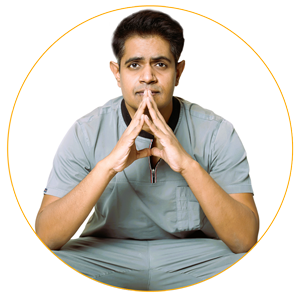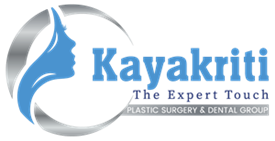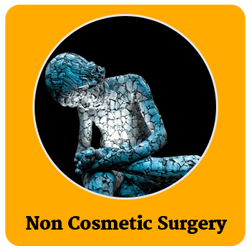Jaw Tumors - Excision with Reconstruction
Jaw tumors are tumors of the bones of the upper and lower jaw.

Best Jaw Tumors - Excision with Reconstruction Surgery in India
What are Jaw Tumors?
Jaw tumors are tumors of the bones of the upper and lower jaw. They can be benign or cancerous. Jaw tumors cause quite discomfort to the patients as they can grow to big size and even if the tumors are non-cancerous, patients experience problems in eating, speaking,, and swallowing.
How are tumors discovered?
- Some tumors are discovered on routine dental X-rays while others are discovered after examination of the mouth.
- CT scan of the face and neck is important to see the exact size, and shape of the tumor and the structures involved in it.
What are the types of Jaw Tumors?
The most common types of jaw tumors are Ameloblastoma, Aneurysmal bone cysts, and Giant cell tumors. Cancers like osteosarcoma, chondrosarcoma, and Ewing's sarcoma are also reported in Jaws.
Out of these, Ameloblastoma is the most common type of benign jaw tumor present in the population. This can attain a big size and is aggressive but never spreads to other parts of the body.
What are the Symptoms of a Jaw tumor?
- Swelling of the jaw (upper or lower)
- Pain
- Loose tooth
- Difficulty in eating, swallowing, and speech
What are the problems seen after the jaw is removed with the tumor?
Surgical excision of a jaw tumor with the removal of the segment of the jaw can cause serious issues in the management of air passages of the person's face. Other problems faced by him/her are difficulty in chewing, speech & cosmesis.
So, after the removal of the jaw, it becomes imperative to restore the continuity of a bone as the basic goal of reconstruction. Jaw reconstruction will also enable its functioning to allow a person to eat, swallow and speak as before & give the surgical site a more cosmetic appearance.
Jaw reconstruction is most commonly performed with the help of the microvascular transfer of bone and soft tissue taken from the leg and fixed with reconstruction plates & screws. It is a highly specialized microvascular surgery procedure consisting of the harvest of bone flap, shaping and fixation of bone, insetting of skin and soft tissues, microvascular anastomoses & external skin closure.
Once the jaw is fixed with the bone flap, artificial teeth can be implanted into the bone after one year of the surgery. This will enable the patient to chew the food from that side of the jaw and improve the cosmesis of their face and smile.
What is the Correct Time for Jaw Reconstruction
Jaw Reconstruction can be done at the time of jaw removal surgery or after a few months or years as a separate surgery.
- Primary Reconstruction - This is performed at the time of the surgical excision of the tumor.
- Secondary Reconstruction - This is performed as a separate procedure after the tumor removal.
Though Primary Reconstruction is preferred more as it restores the structure & function rapidly, reducing the number of operations & the overall duration of stay in the hospital.
What can you expect from Jaw Reconstruction?
- Restore continuity of the mandible/maxilla.
- Restore the height of bone-bearing teeth.
- Reconstruct lower facial contours if the lower jaw is removed or midfacial contours if the upper jaw is removed.
- Preserve Temporo-mandibular Joint.
- Restore adjacent soft tissue defects.
How can you prepare before JawTumorr Surgery?
- CT Scans & X-Rays taken for assessment of the extension of the tumor.
- A biopsy is recommended before proceeding with the definitive surgery
- Pre-operative photographs will be taken which will be used during the process of reconstruction.
- CT Angiogram of the limb can be done to evaluate the blood vessels of the donor site.
- Arrange one unit of blood
- Admit a day before the surgery.
- Highlight the importance of tracheostomy (a hole is made in the windpipe during the surgery for bypassing the oral cavity), the need for ICU care, and post-operative ventilation after the surgery.
- Consent is to be taken for microvascular surgical re-exploration if vessels get blocked after the surgery.
Dr Amit Agarwals focus during consultation
- Size, extent & prognosis of tumor requiring resection.
- Location & extent of defect of the lower jaw (mandibular)/upper jaw (maxilla) defect.
- Presence of remaining teeth.
- Degree of post mandibulectomy rotation & deviation.
- Available mouth opening.
- Functional limitation of the tongue.
- Amount of remaining soft tissue.
- Age & general health of the patient.
The surgical procedure of Jaw tumor Excision and Reconstruction
The treatment of jaw tumors, both upper and lower jaw- comprises majorly of Surgical Intervention, Radiation Therapy, or a combined treatment comprising of Chemotherapy as well. Surgical excision of the tumor with the removal of the segment of the jaw along with the reconstruction of the jaw is done in the same sitting.
Jaw Excision
It can be either lower jaw (mandible) or upper jaw (maxilla) excision depending on the location of the tumor.
- Lower Jaw (Mandibular) Excision/Mandibulectomy - It is the surgical removal of all or part of the lower jawbone. It can be of 3 types-
- Marginal mandibulectomy - When the upper margin of the bone of the lower jaw is removed and the lower rim is kept intact. No reconstruction is required usually.
- Segmental Mandibulectomy - When a complete segment of the lower jaw is removed. Reconstruction is required.
- Hemimandibulectomy - When half of the lower jaw is removed. Reconstruction is required
- Upper Jaw (Maxilla) Excision/Maxillectomy - It is the surgical removal of all or part of the upper jawbone. It can be of 3 types-
- Partial Maxillectomy - When a partial portion of the upper jaw is removed. No reconstruction is required.
- Subtotal Maxillectomy - When the complete upper jaw is removed but the orbital floor is kept intact. Reconstruction is required.
- Total maxillectomy - When the complete upper jaw is removed with a floor of the orbit. Reconstruction is required.
Initially, general anesthesia is administered by a very competent anesthetist and intensivist. Tracheostomy is done if required. A Ryles's nasogastric tube is inserted through the nose and a urinary catheter is placed for draining urine and monitoring.
Jaw resection is done through an appropriate incision by an Oncosurgeon.
Reconstruction of Jaw
Reconstruction of both the lower and upper jaw is challenging but reconstruction of the upper jaw is more difficult.
- Reconstruction with Plate only - is not done and advised by Dr. Amit Agarwal to anyone now. It is only done or indicated in patients who are-
- Medically unfit for major surgery.
- Having poor prognosis.
- Reconstruction using Bone Grafts - This technique is used in defects less than 3-4cm in length but the soft tissues need to be in very good condition with a good blood supply. This is also not the best method of reconstruction as the chances of bone absorption and disappearance are very high.
- Reconstruction using Microsurgical Bone Flaps - (Best method) Reconstruction using microsurgical bone flaps is the best method and is done by taking tissues and bone from the leg, Free Fibula Flap.
Fibula Bone which is the smaller one of the two bones present in the leg can be used to reconstruct both the lower and upper jaw. The bone is harvested with its artery, vein, and skin. The flap is then transferred to the head and neck region. The bone is reshaped and is fixed with the remaining jaw bone with plates, skin and soft tissues taken with the bone are inset in the defect created after the excision, and the vessels are anastomosed at the recipient site with appropriate artery and vein.
The donor site is covered with the help of a skin graft taken from the thigh.
Removing part of the fibula bone from the leg does not create any problem in walking or movements of the leg and foot.
Factors Affecting Results of Free fibula Flap
- Size of the defect.
- Timing of reconstruction.
- Radiotherapy is given before planning reconstruction or not.
- Post-operative Recipient Site Complications.
- Intraoral communication.
This surgery needs surgical expertise and a good working team. Dr. Amit Agarwal specializes in microsurgical reconstruction and has reconstructed innumerable jaws with free fibula bone.
Post Jaw Reconstruction Surgery
Recovery after Free fibula flap surgery for Jaw Tumor
- The patient should be kept in ICU for a minimum of one to 2 days. There could be a possibility that the patient is kept on a ventilator for one day.
- The flap is monitored frequently post-surgery. Hospital stay is increased with microvascular free fibula reconstruction but it is the best modality to cover the defects in the jaw after tumor removal.
- The patient is kept on antibiotics, IV Fluids, and analgesics for pain.
- Head end elevation is to be maintained for the next 3 weeks. Ryle's tube feeding will be given through the nose to bypass the mouth for healing of the sutures in the mouth if the oral mucosa is reconstructed with the jaw.
- Microsurgical techniques are helpful if done at the appropriate time and it also depends on the type of tumor. Post-surgical management is equally important for the overall outcome of the treatment.
- After the surgery, the patient is bedridden for 2-3 weeks. No ambulation is advised and the limb has to be elevated by using pillows underneath. After several dressings, when the operated site is completely stable, the patient is given pressure garments and ambulation is started.
- Further treatment in form of radiotherapy and/or chemotherapy depends on the final histopathology report.
What to do for faster Recovery?
- Betadine mouth gargles are advised 3-4 times a day every day till healing is complete.
- The dressing is done every alternate day.
- Drains from the neck are removed after 4-5 days of surgery but can be kept for a long. The urinary catheter is removed 3-4 days after surgery.
- The patient is admitted for at least 7-8 days and discharged once the flap is settled.
- Sutures are removed after 2 weeks.
When can you return back to routine activities?
- Oral feeds are started after 10-14 days of surgery and then Ryle's nasogastric tube is removed.
- Mouth opening exercises are started after 3 weeks of surgery
- Complete recovery time is of about 3 weeks
Why kayakriti?
The success rate of free fibula reconstruction is quite good around 95% in hands of Dr. Amit Agarwal. It means 95 out of 100 jaws are successfully reconstructed. The results of microsurgical reconstruction can be quite unpredictable as it is dependent on multiple factors like the status of blood vessels, level of immunity of the patient and his/ her health status, and protein level to withstand the procedure.
Post-operative Complications of Free Fibula Flap for Jaw tumor
- Risks related to anesthesia. General Anaesthesia is very safe in present times and with the best machines and a qualified anesthetist, the chances of encountering any complication are less than 0.1 percent in a healthy individual.
- Risks related to Microsurgical reconstruction of flap technique like thrombosis or blood clot in the vessels of the flap, re-exploration / re-surgery to remove these clots, and flap failure is seen in less than 5 percent of cases.
- Few patients develop some degree of skin slough or partial flap necrosis. This was more often the case in smokers, in people with multiple diseases, and also in patients having undergone anastomotic revision.
- Oro-cutaneous fistula – there is a possibility of developing communication between the cavity of the mouth and the external skin through the sutures of the neck. The chances increase with advancing age, bad nutritional status, and disease of the patient. This can lead to catastrophic consequences if not treated in time. This might require revision surgery in terms of fistula closure.
- Rare chances of infection whichresponses to prolonged antibiotic therapy.
- Bleeding or hematoma formation can occur which might require drainage.
- Poor wound healing because of poor blood supply of the flap. Seen more commonly in smokers, diabetes, hypothyroidism, and individuals with multiple comorbidities. Poor wound healing can lead to skin discoloration which can cause marginal or total skin necrosis
- Scars will be there along the incision line which will fade with time. Scars can get hypertrophied if you are prone to it.
- Rare events of Deep vein thrombosis and pulmonary or cardiac complications can occur or precipitate in patients with multiple pre-existing diseases diagnosed or undiagnosed by routinely available standard tests.
- Possibility of revision surgery in case of flap failure, and graft loss.
- Facial Asymmetry
- Non-union of the jawbone.
- Tooth Loss.
- TMJ Ankylosis.
Know your surgeon better

Best plastic surgeon, Dr. Amit Agarwal is an American Board Certified, extensively trained, and best Plastic & Aesthetic surgeon in Lucknow. He is the Chief Plastic Surgeon heading the Department of Plastic, Microvascular, and Craniofacial surgery at Vivekananda Polyclinic and Institute of Medical Sciences, Lucknow, U.P, India. He maintains a busy practice at Avadh and Nishat Hospital and his own center - Kayakriti Plastic Surgery & Dental Center. He was formerly a Consultant in the Department of Plastic Surgery and Burns at the prestigious SGPGI, Lucknow.
MS, DNB (General Surgery) MCh, DNB (Plastic Surgery),
MNAMS, FACS, FICS, FRCS (Edinburgh, UK)
His Credentials
Three pillars of kayakriti
Privacy
We believe your experience with us should be comfortable and hassle-free to make it one of your best lifetime experiences for yours. We, here at the clinic, take full precautions to maintain your privacy in any manner. We also provide a staff who will receive you from the gate and take you to the chamber directly if you demand.
Trust
Our Surgeon is highly qualified and internationally certified with a team of skilled staff to perform any surgical or non-surgical treatment on your body.
Safety
When you plan to undergo any surgery you should always keep in mind that it's your body and it's a surgery. We, here always keep your safety a priority and will never recommend you to undergo any such procedure which is not safe for you. We also provide you with a detailed description of the complications which may occur after the surgery during the consultation as it's a surgical procedure so there may be some complications depending on the way your body reacts.
Kayakriti in news



Frequently Asked Questions
If you have flat or small breast and you want to improve your breast and hip contour ratio then you are a good candidate for it. The answer will be best provided after the first consultation with Dr Amit Agarwal.
Acute pain will be there for almost a week which gradually reduces and there will be soreness and swelling which may take up to 3 weeks to subside.
You can join your work and daily routines after a week of the procedure and can start exercising after 3 weeks of it.
Yes, you have to wear it round the clock unless we suggest you to remove it.
This surgery does not affect the ducts or the areas of the breast involved in milk production. Thus, it does not affect the breast feeding.
This surgery does not affect the ducts or the areas of the breast involved in milk production. Thus, it does not affect the breast feeding.












Kayakriti Plastic Surgery & Dental Center
D-43, Near Punjab National Bank, Rajajipuram, Lucknow, Uttar Pradesh - 226017, India
Phone No. +919695940009, +919695940006
Map Location





























Social Media Presence